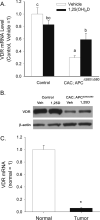The effect of 1,25 dihydroxyvitamin D3 treatment on the mRNA levels of β catenin target genes in mice with colonic inactivation of both APC alleles
- PMID: 25597951
- PMCID: PMC4361272
- DOI: 10.1016/j.jsbmb.2015.01.009
The effect of 1,25 dihydroxyvitamin D3 treatment on the mRNA levels of β catenin target genes in mice with colonic inactivation of both APC alleles
Abstract
In colon cancer, adenomatous polyposis coli (APC) inactivating gene mutations increase nuclear β-catenin levels and stimulate proliferation. In vitro, 1,25 dihydroxyvitamin D (1,25(OH)2D), suppresses β-catenin-mediated gene transcription by inducing vitamin D receptor (VDR)-β-catenin interactions. We examined whether acute treatment with 1,25(OH)2D could suppress β-catenin-mediated gene transcription in the hyperplastic colonic lesions of mice with colon-specific deletion of both APC gene alleles (CAC; APC(Δ580/Δ580)). At four weeks of age, CAC; APC(Δ580/Δ580) and control mice were injected with vehicle or 1,25(OH)2D (1μg/kg body weight) once a day for three days and then killed six hours after the last injection. mRNA levels of β-catenin target genes were elevated in the colon of CAC; APC(Δ580/Δ580) mice. 1,25(OH)2D increased 25 hydroxyvitamin D-24 hydroxylase mRNA levels in the colon of CAC; APC(Δ580/Δ580) and control mice indicating the treatments activated the VDR. However, 1,25(OH)2D had no effect on either β-catenin target gene mRNA levels or the proliferation index in CAC; APC(Δ580/Δ580) or control mice. VDR mRNA and protein levels were lower (-65% and -90%) in the colon of CAC; APC(Δ580/Δ580) mice compared to control mice, suggesting loss of colon responsiveness to vitamin D. Consistent with this, vitamin D-induced expression of transient receptor potential cation channel, subfamily V, member 6 mRNA was reduced in the colon of CAC; APC(Δ580/Δ580) mice. Our data show that short term exposure to 1,25(OH)2D does not suppress colonic β-catenin signaling in vivo. This article is part of a special issue entitled '17th Vitamin D Workshop'.
Keywords: Cancer; Gene expression; Hyperplasia; Vitamin D.
Copyright © 2015 Elsevier Ltd. All rights reserved.
Figures





Similar articles
-
Vitamin D receptor deficiency enhances Wnt/β-catenin signaling and tumor burden in colon cancer.PLoS One. 2011;6(8):e23524. doi: 10.1371/journal.pone.0023524. Epub 2011 Aug 15. PLoS One. 2011. PMID: 21858154 Free PMC article.
-
Effect of 1,25-dihydroxyvitamin D3 on the Wnt pathway in non-malignant colonic cells.J Steroid Biochem Mol Biol. 2016 Jan;155(Pt B):224-30. doi: 10.1016/j.jsbmb.2015.02.011. Epub 2015 Mar 14. J Steroid Biochem Mol Biol. 2016. PMID: 25777538
-
Temporal changes in tissue 1α,25-dihydroxyvitamin D3, vitamin D receptor target genes, and calcium and PTH levels after 1,25(OH)2D3 treatment in mice.Am J Physiol Endocrinol Metab. 2013 May 1;304(9):E977-89. doi: 10.1152/ajpendo.00489.2012. Epub 2013 Mar 12. Am J Physiol Endocrinol Metab. 2013. PMID: 23482451
-
Reciprocal role of vitamin D receptor on β-catenin regulated keratinocyte proliferation and differentiation.J Steroid Biochem Mol Biol. 2014 Oct;144 Pt A:237-41. doi: 10.1016/j.jsbmb.2013.11.002. Epub 2013 Nov 12. J Steroid Biochem Mol Biol. 2014. PMID: 24239508 Free PMC article. Review.
-
Vitamin D and Wnt/beta-catenin pathway in colon cancer: role and regulation of DICKKOPF genes.Anticancer Res. 2008 Sep-Oct;28(5A):2613-23. Anticancer Res. 2008. PMID: 19035286 Review.
Cited by
-
Vitamin D3 enhances the tumouricidal effects of 5-Fluorouracil through multipathway mechanisms in azoxymethane rat model of colon cancer.J Exp Clin Cancer Res. 2015 Jul 25;34(1):71. doi: 10.1186/s13046-015-0187-9. J Exp Clin Cancer Res. 2015. PMID: 26205949 Free PMC article.
-
Constitutively active RAS signaling reduces 1,25 dihydroxyvitamin D-mediated gene transcription in intestinal epithelial cells by reducing vitamin D receptor expression.J Steroid Biochem Mol Biol. 2017 Oct;173:194-201. doi: 10.1016/j.jsbmb.2017.01.008. Epub 2017 Jan 16. J Steroid Biochem Mol Biol. 2017. PMID: 28104492 Free PMC article.
References
-
- Huxley RR, Ansary-Moghaddam A, Clifton P, Czernichow S, Parr CL, Woodward M. The impact of dietary and lifestyle risk factors on risk of colorectal cancer: A quantitative overview of the epidemiological evidence. Int J Cancer. 2009;125(1):171–180. - PubMed
-
- Willett WC. Balancing life-style and genomics research for disease prevention. Science. 2002;296(5568):695–698. - PubMed
-
- Feskanich D, Ma J, Fuchs CS, Kirkner GJ, Hankinson SE, Hollis BW, Giovannucci EL. Plasma vitamin D metabolites and risk of colorectal cancer in women. Cancer Epidemiol Biomarkers Prev. 2004;13(9):1502–1508. - PubMed
-
- Tangrea J, Helzlsouer K, Pietinen P, Taylor P, Hollis B, Virtamo J, Albanes D. Serum levels of vitamin D metabolites and the subsequent risk of colon and rectal cancer in Finnish men. Cancer Causes Control. 1997;8(4):615–625. - PubMed
-
- Jenab M, Bueno-de-Mesquita HB, Ferrari P, van Duijnhoven FJB, Norat T, Pischon T, Jansen EHJM, Slimani N, Byrnes G, Rinaldi S, Tjonneland A, Olsen A, Overvad K, Boutron-Ruault MC, Clavel-Chapelon F, Morois S, Kaaks R, Linseisen J, Boeing H, Bergmann MM, Trichopoulou A, Misirli G, Trichopoulos D, Berrino F, Vineis P, Panico S, Palli D, Tumino R, Ros MM, van Gils CH, Peeters PH, Brustad M, Lund E, Tormo MJ, Ardanaz E, Rodriguez L, Sanchez MJ, Dorronsoro M, Gonzalez CA, Hallmans G, Palmqvist R, Roddam A, Key TJ, Khaw KT, Autier P, Hainaut P, Riboli E. Association between pre-diagnostic circulating vitamin D concentration and risk of colorectal cancer in European populations:a nested case-control study. BMJ. 2010;340(jan21_3):b5500. - PMC - PubMed
Publication types
MeSH terms
Substances
Grants and funding
LinkOut - more resources
Full Text Sources
Other Literature Sources
Medical

